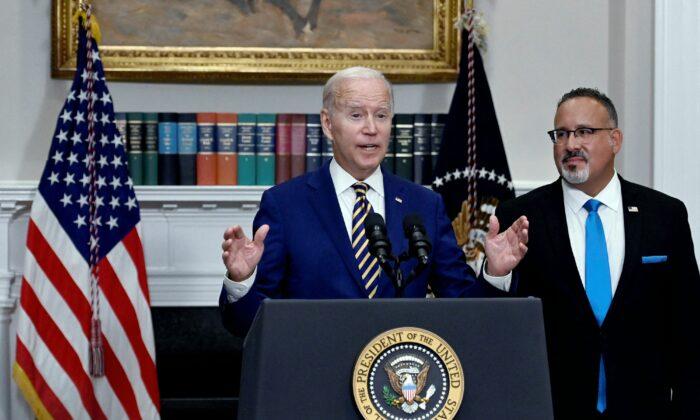President Joe Biden has offered student debtors some relief. Legal challenges question whether he has the authority to make such a financial commitment. However, even if the White House prevails in court, arguments pro and con will still matter, especially as the nation approaches this year’s midterm elections and the 2024 presidential contest.
Here’s what the White House plans. It would extend to Dec. 31 the existing pause in student loan repayments. It would give up to $20,000 of debt forgiveness to all Pell Grant recipients and up to $10,000 in forgiveness to non-Pell Grant recipients with incomes up to $125,000 a year and married couples with incomes up to $250,000 a year. Debtors who work for certain nonprofits, in the military, or for federal, state, tribal, or local governments can have their student debt forgiven entirely through the Public Service Loan Forgiveness program.
While the White House argues for this action in terms of the urgent needs of some 45 million young Americans burdened by some $1.6 trillion in federal student loan debt, questions nonetheless arise in three areas: the value of a program that effectively pushes many young people into college, matters of equity, and whether this approach gets to the root of the problem.
The first of these objections effectively takes exception to the White House assertion that college is, in the words of its own fact sheet, a “ticket to a middle-class life.” If the degree were, in fact, such a “ticket,” the debt wouldn’t seem so onerous to so many. This grim reality causes many to raise the counterargument that many who presently attend college would do better in trade schools or apprenticeship programs. From this perspective, debt forgiveness only fosters a dysfunctional pattern.

Then, there are questions of equity. One part of these objections considers those who saved for college or have already paid down a significant portion of their debt. Forgiveness laughs at their sacrifice. Those who set themselves up in a business or a trade might question why Washington isn’t helping them.
Nor does debt forgiveness consider future students. To be sure, part of the White House order would limit the amount of debt service to 5 percent of a debtor’s discretionary income and ensure that debt couldn’t grow as a portion of the borrower’s income.
But these provisions fall far short of what’s being offered to existing debtors.
A full consideration of equity would also have to go beyond the apportion of benefits and consider who pays. Because the debt is owed to the government, forgiveness would deny the budget a source of revenue. Debt relief would then burden all taxpayers. Those who have already paid down their debt would not only miss the benefit, but also see a federal budget much less able to provide other services they might need.
Such a constrained budget would make it hard for others still less fortunate to argue for the services they need, many of them low-income people who never even considered college, perhaps for financial reasons. A single mother supporting her family off a meager paycheck might prefer that Washington extend food stamp subsidies rather than give up revenue for the sake of credentialed college graduates.
None of these alternatives are necessarily more worthy than helping indebted students, but a consideration of fairness surely demands that people weigh these aspects of the debt forgiveness question.
The final set of objections takes up the root of the problem, which, as the White House material itself points out, is the rapidly rising cost of college. Many have argued that the easy terms of student lending have facilitated price increases at private and public educational institutions alike. In this, the debt has benefitted college administrations and faculties more than anyone.
This presidential order would shift the burden for those benefits to taxpayers from the students. Still, the fuel for college cost increases would remain and continue to benefit those in administrations and faculties, possibly the most privileged people in the nation.
It’s easy to want to help young people struggling with their finances, especially because many were duped into believing that their course of study would enable them to discharge the debt more easily than it has.
This order, however well-intentioned, also has significant drawbacks, as is almost always the case with public policy matters. These drawbacks are legitimate and need to be aired even if, in the end, the order proceeds, and the population has to accept it.





